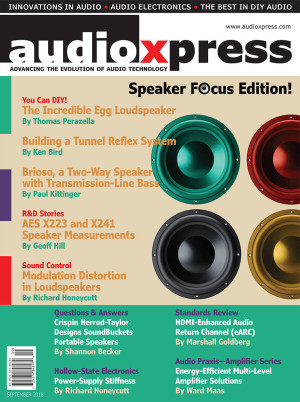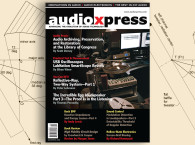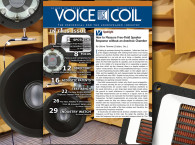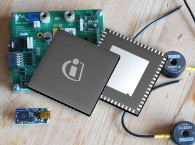
On our cover, we highlight a bold speaker project by Tom Perazella, influenced by the latest generation of SB Acoustics' high-end drivers, including the brand's flagship TW29BN high-end beryllium dome tweeter and part of its Satori top-performing range. Perazella designed the project based on the Mach 17 speaker built by Waveform Research of Canada in the 1990s, creating an outstanding three-way configuration, including a top "egg-designed" speaker featuring the new Satori drivers, with a separate trapezoidal-shaped low-frequency sealed box cabinet, using two Dayton RSS315HO-44 12" woofers. In the first part of this complex construction, we detail the choice of drivers and how the egg-shaped top cabinets were designed.
Next, and continuing with the DIY approach, we detail a two-way speaker, The Brioso, using a Scan-Speak Revelator midwoofer and a Transducer Labs Alumina ceramic dome tweeter in a floor-standing, mass-loaded transmission-line (ML-TL) enclosure. This project, by speaker builder Paul Kittinger, was awarded first place at the 2017 Midwest Audiofest (MWAF) event held by Parts Express.
And to complete our special focus on practical speaker projects, our speaker builder enthusiast Ken Bird explains his "Tunnel Reflex" design, which uses a single full-range high-compliance driver loaded by a transmission-line style tunnel. This is essentially a modified version of the “Bullhorn” Speaker System, a popular 1960s design from Admiral Corp., originally created to fit the best possible speakers in a typical stereo console of the time. After recalling this unique design that produced an amazing sound from small drivers, Ken Bird decided to build a modified version, and details how you can make your own set.
And because speaker design is impossible without relying on proper measurements, Geoff Hill brings a valuable perspective on the latest efforts, translated in the published Audio Engineering Society (AES) X223 and X241 information documents on speaker measurements. Sharing his extensive experience in this domain, Hill explains how these efforts might contribute to controlled measurement environments and calibration methodologies, which could finally overcome many of the limitations the industry has been facing for decades.
In his monthly Sound Control column, Richard Honeycutt addresses a key topic that has not been sufficiently discussed, “Modulation Distortion in Loudspeakers and Its Detectability.” In this first article on the subject, the article discusses Doppler distortion and how this phenomena has been investigated over the years, leading to a better understanding of intermodulation distortion (IMD) and amplitude-modulation distortion (AMD) effects.
In this edition, Honeycutt also reviews the Fundamental Amplifier Techniques with Electron Tubes, the second and more extensive edition of this electronics classic by Rudolf Moers.
The September edition of audioXpress also includes another exploration of the latest Class-D technologies. This month, Ward Maas tells the story of Danish-sensation Merus Audio, the company founded in 2010 by Hans Hasselby-Andersen and Mikkel Hoyerby, and recently acquired by Infineon Technologies. The article recalls how this Copenhagen-based start-up quickly ascended in the audio industry with its new generation of energy-efficient integrated Class-D amplifier solutions. Now available as Infineon's Multi-Level amplifier range, the underlying technology is certainly an important contribution to minimizing heat and design space, and maximizing audio performance and battery playback time for smart home and battery-powered speakers.
Another very important read, particularly for developers working on soundbars and any home-theater related speaker design or components, Marshall Goldberg explains everything you need to know about the latest HDMI 2.1 Enhanced Audio Return Channel (eARC) specification. The new eARC feature introduces forward compatibility between the AVR and the TV, providing a number of improvements over existing home theater audio connectivity methods. A must read.
 Our interview for this month is with Crispin Herrod-Taylor, the co-founder of British pro audio company Crookwood and the creator of the latest Kickstarter sensation in terms of portable Bluetooth speakers, SoundBuckets. Shannon Becker questions this audio engineer about how the SoundBuckets design came about, and the pros and cons of trying the crowdfunding approach.
Our interview for this month is with Crispin Herrod-Taylor, the co-founder of British pro audio company Crookwood and the creator of the latest Kickstarter sensation in terms of portable Bluetooth speakers, SoundBuckets. Shannon Becker questions this audio engineer about how the SoundBuckets design came about, and the pros and cons of trying the crowdfunding approach.Finally, in Hollow-State Electronics, you can read how “The Measured Effect of Power-Supply Stiffness” affects Power Amplifier Performance. If you are wondering, "stiffness" is an informal term describing the load voltage regulation of a power supply.
All this is now available on print and online. Get the September 2018 edition of audioXpress now at: www.gotomyxpress.com
And of course you can also subscribe here: www.audioxpress.com/page/audioXpress-Subscription-Services.html
If you wish to buy a single printed issue or the complete audioXpress archive on USB, from 2000 to 2018 (yes, including the latest issue), just visit our online shop at www.cc-webshop.com






